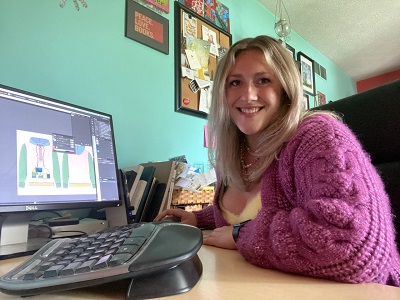Fashion for Anxiety
 Katelyn Haas, a recent graduate from CMU’s Apparel Product Development and Merchandising Technologies program, designed a fashion-forward garment to ease anxiety in the wearer. Haas recognized a lack of discreet tools to help manage anxiety, and thus created four garment prototypes, each of which features different fidget components and aesthetics. Haas emphasizes that while most coping strategies are not meant to replace seeking professional help, they can reduce feelings of panic and stress when better resources are not available.
Katelyn Haas, a recent graduate from CMU’s Apparel Product Development and Merchandising Technologies program, designed a fashion-forward garment to ease anxiety in the wearer. Haas recognized a lack of discreet tools to help manage anxiety, and thus created four garment prototypes, each of which features different fidget components and aesthetics. Haas emphasizes that while most coping strategies are not meant to replace seeking professional help, they can reduce feelings of panic and stress when better resources are not available.
Anxiety disorders are the most common mental illness in the United States, and these have only been exacerbated with the COVID-19 pandemic. Haas found that those who struggle with mental illness often seek out more affordable alternatives, such as fidgeting, before reaching out to a professional for help. The calming effects of fidgeting, which includes leg bouncing, tapping of one’s foot or fingers, rapid eye blinking, etc. can also be achieved using objects.
 Haas conducted an online survey to analyze consumers’ attitudes and preferences toward different anxiety-relieving products such as fidget spinners and fidget cubes. Based on the feedback from the survey, those sampled would be interested in testing out a fidget garment to help relieve stress. From there, Haas designed four fashion-forward garments that incorporated discreet fidgeting components. Due to strict social distancing guidelines, the prototypes were all designed digitally and presented to survey respondents via WebEx.
Haas conducted an online survey to analyze consumers’ attitudes and preferences toward different anxiety-relieving products such as fidget spinners and fidget cubes. Based on the feedback from the survey, those sampled would be interested in testing out a fidget garment to help relieve stress. From there, Haas designed four fashion-forward garments that incorporated discreet fidgeting components. Due to strict social distancing guidelines, the prototypes were all designed digitally and presented to survey respondents via WebEx.
When designing the prototypes, Haas took into consideration the aesthetic preferences of those sampled: comfortable pullover styles made of neutral or pastel colors. Design A is a green hoodie that features a multi-drawstring fidget component on the exterior. Design B is a pastel hoodie that features an athleisure-style zipper that offers auditory and physical stimulation to help calm the wearer. Designs C and D are neutral-colored sweatshirts made from a variety of textured fabrics. Along with the exterior stimulants, each prototype incorporates a more discreet fidget toy such as mancala marbles and a detachable fidget cube that hides in the garments’ sleeves or pockets.
Once the prototypes were finalized, they each were rated by a focus group comprised of the online survey respondents. Design B prevailed as the most preferred garment. Haas’ research proved successful in fulfilling a desire for a unique yet functional garment designed to ease anxiety in the wearer.
The value of Haas’ research is highlighted by her winning the 2021 ITAA Student Best Paper Competition in April under Dr. Su An’s supervision and having her paper selected as the second-place winner at the Master's level. She will present her master's research orally at the annual ITAA conference as the student winner.
At CMU, we do research and real-world results.
Story by ORGS intern Hailey Nelson
August 2021